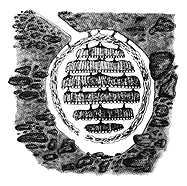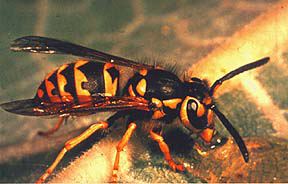...... on the trail, 25 miles from the nearest dirt road. You just mixed up a little Tang® in your canteen then set the open container aside so you could put your aching feet in the creek. While you're cooling your feet, the ravenous Yellowjackets are helping themselves to some Tang®. When you get back to your canteen, you take a long refreshing slug, then........ YEAAAAAOOOOOOH ! You are now a victim!
For Scouts on the trail, in a camping site, or even at a leisurly picnic, Yellowjackets can ruin ruin your day, and for some people, they can end your life!
They defend themselves by delivering a powerful sting which causes pain, swelling and itching. Certain people who are allergic can suffer serious medical complications (or death) from even a single sting. For the experienced, they are mostly an annoyance, but just in case, you need to BE PREPARED.
Yellowjackets are smaller than most hornets and wasps. They also appear to be stouter in appearance. They are distinctively black and yellow in body color.
In much of the USA these little suckers are everywhere during the summer. Some of the varieties of Yellowjacket you might encounter include:
Western Yellowjacket (Vespula pensylvanica)
This Yellowjacket is a big-time major pest species in California. It is primarily a scavenger and in the summer months adults are common whether you're on the trail or just in state park picnic areas. Nests are usually constructed in abandoned rodent burrows or in man-made structures like walls and attics. Nests contain 500 to 5,000 workers and start to decline in late September to October.
Common Yellowjacket (Vespula vulgaris)
This Yellowjacket can be a pest because adults are attracted to protein or sugar sources. This species is also considered a beneficial organism because workers prey on caterpillars and other insects. Nests are mostly subterranean but can be constructed inside house walls or in aerial locations. Nests are large and contain 500 to 5,000 workers. Nests remain active until September
to December.
Bald Faced Hornet (Dolichovespula maculata)
Not really a Yellowjacket, but pretty darn close, this cream and black colored wasp lives in wooded regions in northern California. It is a summertime pest in recreational as well as suburban areas. This species constructs a football-shaped nest attached to trees and buildings. Foragers are present from June to October.
Prairie Yellowjacket (Vespula atropilosa)
This Yellowjacket is not a pest. It feeds on live insects, helping to control flies or caterpillars. Nests are constructed in the ground in open areas like grasslands or golf courses. Nests contain
75 to 400 workers and start to decline in late August to September.
Aerial Yellowjacket (Dolichovespula arenaria)
This Yellowjacket is a beneficial organism. Workers prey on flies and caterpillars and rarely scavenge. They build small aerial nests that contain 100 to 700 workers. Nests begin to decline in July to September.
[ Back To Top ]
When is Yellowjacket season?
The season begins anywhere from March to May (depending upon the climate) through September. The queens emerge in early May to select a nest site to lay eggs, and the worker population grows to maximum size inAugust or September.
[ Back To Top ]
 Where do they live?
Where do they live?
Yellowjackets live in colonies (actually large families) housed in nests. Some species attach the nest to trees, shrubs or buildings. Native pest species usually construct nests underground, often in old rodent burrows (see illustration at left.). A newly arrived immigrant species, the German Yellowjacket tends to nest inside buildings. Nests can be found by observing the flight pattern of the Yellowjacket. They will land on the ground and disappear! A closer look will reveal a tunnel. Later in the year, the entrance hole will have dirt and pebbles piled around it. This debris is the result of expansion activities in the nest. Each colony is ruled by a single queen - there are no kings.
[ Back To Top ]
How do they build the nest?
Nests are constructed from paper. Yellowjackets make a pulp by gathering wood or plant fibers, chewing it up and mixing in some of their own saliva. When the pulp is spread out it dries to form paper. The inner core of the nest is a series of horizontal combs which contain many six- sided cells used for rearing immatures. The core is surrounded by a spherical envelope of overlapping sheets of paper.
[ Back To Top ]
What do they eat?
Yellowjackets are predators, much in the same mold as bald-faced hornets and paper wasps. They will actively scavenge any source of animal protein. Late in the summer they also acquire a sweet tooth and are attracted to and eat sweet foods like honey, candy, fruits, soft drinks, etc. For protein they hunt other insects and spiders. In addition, the common pest species collect red meats, chicken and fish - the same foods that people often carry on the trail or bring to eat in parks. They are also commonly seen buzzing around garbage.
[ Back To Top ]
Why are there so many Yellowjackets?
Because Yellowjackets feed on the same types of food as humans, they are encouraged to grow and multiply when this food is easily available. Good sanitation is essential in controlling Yellowjacket populations, and proper disposal of garbage will help keep your campsite area safe.
[ Back To Top ]
What is the difference between Queen and Worker Yellowjackets?
The queens can be up to three times larger and wider than the workers. Queens are the first to emerge in the spring (usually May) when they selecta nest site and lay their eggs. The workers emerge about 30 days later, andthe colony attains maximum size -- up to 4,000 workers -- in August or September. Setting one of the commercially available reusable traps out in the spring can catch several queens and thereby eliminate a potential 4,000 Yellowjacketworkers per queen.
[ Back To Top ]
What is the difference between Yellowjackets and Paper Wasps?
The yellow and black coloring may appear similar, but paper wasps have slender abdomens, and longer legs that dangle down while they are flight. Their nests are built under eaves and in attics, while Yellowjackets most often will build their nests in the ground. The appearance of their nests is also different. Paper wasp nests look like honeycombs with multiple openings, while Yellowjacket nests have only one opening.
[ Back To Top ]
Why do they sting?
Yellowjackets sting only when they sense a threat to themselves or their colonies. Those flying about freely are looking for food, and will usually not sting unless swatted at or accidentally touched. Those near the nest will attack anything that disturbs the ground or passes close by.
[ Back To Top ]
 How to avoid getting stung
How to avoid getting stung
- Don't go barefoot.
- Don't swat with your hands.
- Use lids on soft drinks.
- Check food before you put it in your mouth.
- Avoid using things Yellowjackets are attracted to (perfume and other scents, hairspray, suntan lotion, brightly colored clothes, sweets).
- To manage wasps at picnics and around food, try hanging a piece of meat or fish over a gallon container of soapy water. When these insects leave the hanging bait, they often drop down a short distance before beginning to fly, dropping into the water. Braunswagger sausage is said to work well.
[ Back To Top ]
What to do if you are stung
- If the stinger remains in your skin, quickly remove it. Much has been written about the proper way to remove a stinger, but new information indicates that it doesn't matter how you get it out as long as it is removed as soon as possible. If removed within 15 seconds of the sting, the severity of the sting is reduced.
- After the stinger is removed, wash the wound and treat it. Several over-the-counter products or simply a cold compress can be used to alleviate the pain of a sting. Aerosol or cream antihistamine preparations that contain a skin coolant can also help.
- Lie down.
- Lower the stung arm or leg.
- Do not take alcohol.
- If the sting is followed by severe symptoms, or if it occurs on the neck or mouth, seek medical attention immediately because swelling in these areas of the body can cause suffocation.
[ Back To Top ]
Allergy and Anaphylactic Shock
People who are highly allergic to Yellowjacket venom may develop serious medical problems. If you have any of the following symptoms SEEK IMMEDIATE EMERGENCY TREATMENT: hives, widespread swelling of limbs, painful joints, wheezing, shortness of breath, faintness, dizziness, vomiting, abdominal cramps, diarrhea, nasal discharge or stuffiness, tightening of the throat. This is a serious emergency! If you have access to a phone DIAL 911, if not you will need to get the victim to a doctor immediately.
Individuals who are aware that they are allergic to stings should carry epinephrine (adrenaline) in either a normal syringe (sting kit) or in an auto-injector (Epi-Pen) whenever they think they may encounter stinging insects. Click here for more information.
[ Back To Top ]
I think I have a Yellowjacket nest in my yard. What should I do?
We recommend calling a professional pest control operator to remove the nest because of the danger involved.
[ Back To Top ]
Integrated Hornet and Yellowjacket Management
There are two principal aspects to management: elimination and prevention.
- Elimination
The most important thing to remember is to not risk your personal safety or health. These colonies may be very large (perhaps several hundred individuals) and their location may be accessible only by using a ladder. Wear protective clothing. These insects sting and their venom packs a pretty good wallop.
If you decide to treat the colony with an insecticide only do it at dusk or dawn when their behavior is the most docile. Once the treatment is applied plug the hole and get out of there. Observe the colony for activity. If there is still activity after a couple of days repeat the treatment. If you must climb a ladder to apply the treatment take the proper precaution.
The insecticides recommended are Dursban RTU (Ready-To-Use) and pyrethroid RTU. We recommend this material and method for all above ground nests. For nests below ground, apply Dursban according to label and seal opening with soil.
- Prevention
Keep garbage cleaned up. Caulk cracks and crevices during the winter or early spring. Do not caulk cracks and crevices of active nests! This may cause the colony to eat a hole into a living area inside.
[ Back To Top ]


 How to avoid getting stung
How to avoid getting stung